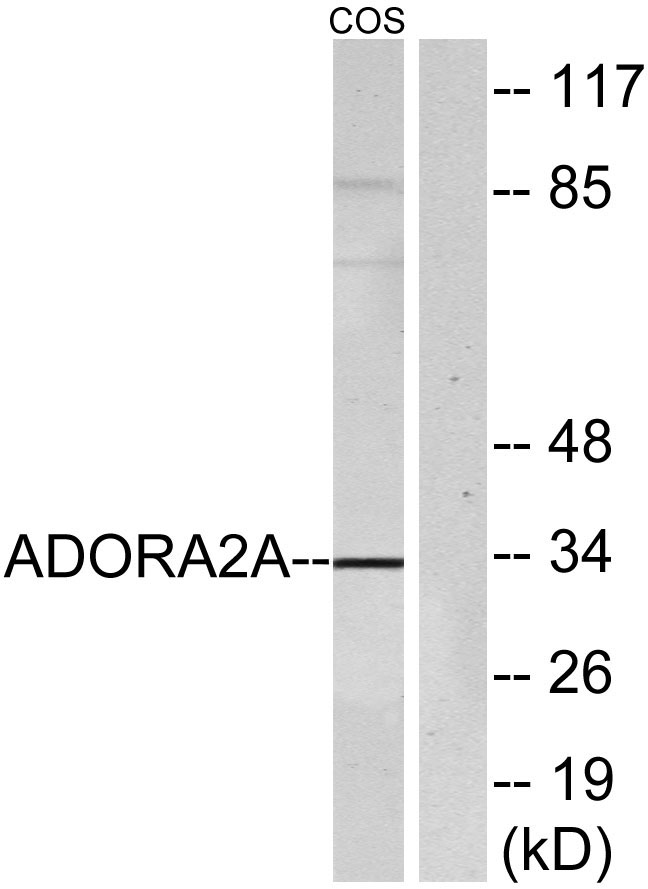Adenosine A2A-R Polyclonal Antibody
- Catalog No.:YT0129
- Applications:WB;IHC;IF;ELISA
- Reactivity:Human;Rat;Mouse;
- Target:
- Adenosine A2A-R
- Fields:
- >>Rap1 signaling pathway;>>Calcium signaling pathway;>>cAMP signaling pathway;>>Neuroactive ligand-receptor interaction;>>Vascular smooth muscle contraction;>>Parkinson disease;>>Alcoholism
- Gene Name:
- ADORA2A
- Protein Name:
- Adenosine receptor A2a
- Human Gene Id:
- 135
- Human Swiss Prot No:
- P29274
- Mouse Swiss Prot No:
- Q60613
- Immunogen:
- The antiserum was produced against synthesized peptide derived from human ADORA2A. AA range:120-169
- Specificity:
- Adenosine A2A-R Polyclonal Antibody detects endogenous levels of Adenosine A2A-R protein.
- Formulation:
- Liquid in PBS containing 50% glycerol, 0.5% BSA and 0.02% sodium azide.
- Source:
- Polyclonal, Rabbit,IgG
- Dilution:
- WB 1:500 - 1:2000. IHC 1:100 - 1:300. IF 1:200 - 1:1000. ELISA: 1:5000. Not yet tested in other applications.
- Purification:
- The antibody was affinity-purified from rabbit antiserum by affinity-chromatography using epitope-specific immunogen.
- Concentration:
- 1 mg/ml
- Storage Stability:
- -15°C to -25°C/1 year(Do not lower than -25°C)
- Other Name:
- ADORA2A;ADORA2;Adenosine receptor A2a
- Observed Band(KD):
- 37kD
- Background:
- adenosine A2a receptor(ADORA2A) Homo sapiens This gene encodes a member of the guanine nucleotide-binding protein (G protein)-coupled receptor (GPCR) superfamily, which is subdivided into classes and subtypes. The receptors are seven-pass transmembrane proteins that respond to extracellular cues and activate intracellular signal transduction pathways. This protein, an adenosine receptor of A2A subtype, uses adenosine as the preferred endogenous agonist and preferentially interacts with the G(s) and G(olf) family of G proteins to increase intracellular cAMP levels. It plays an important role in many biological functions, such as cardiac rhythm and circulation, cerebral and renal blood flow, immune function, pain regulation, and sleep. It has been implicated in pathophysiological conditions such as inflammatory diseases and neurodegenerative disorders. Alternative splicing results in multiple transcript variants. A read-through transcript compos
- Function:
- function:Receptor for adenosine. The activity of this receptor is mediated by G proteins which activate adenylyl cyclase.,similarity:Belongs to the G-protein coupled receptor 1 family.,
- Subcellular Location:
- Cell membrane ; Multi-pass membrane protein . Colocalizes with GAS2L2 at neuronal processes. .
- Expression:
- Brain,Hippocampus,Lymph,Thymus,
- June 19-2018
- WESTERN IMMUNOBLOTTING PROTOCOL
- June 19-2018
- IMMUNOHISTOCHEMISTRY-PARAFFIN PROTOCOL
- June 19-2018
- IMMUNOFLUORESCENCE PROTOCOL
- September 08-2020
- FLOW-CYTOMEYRT-PROTOCOL
- May 20-2022
- Cell-Based ELISA│解您多样本WB检测之困扰
- July 13-2018
- CELL-BASED-ELISA-PROTOCOL-FOR-ACETYL-PROTEIN
- July 13-2018
- CELL-BASED-ELISA-PROTOCOL-FOR-PHOSPHO-PROTEIN
- July 13-2018
- Antibody-FAQs
- Products Images

- Immunofluorescence analysis of COS7 cells, using ADORA2A Antibody. The picture on the right is blocked with the synthesized peptide.

- Immunohistochemistry analysis of paraffin-embedded human brain tissue, using ADORA2A Antibody. The picture on the right is blocked with the synthesized peptide.

- Western blot analysis of ADORA2A Antibody. The lane on the right is blocked with the ADORA2A peptide.

- Western blot analysis of the lysates from HepG2 cells using ADORA2A antibody.



